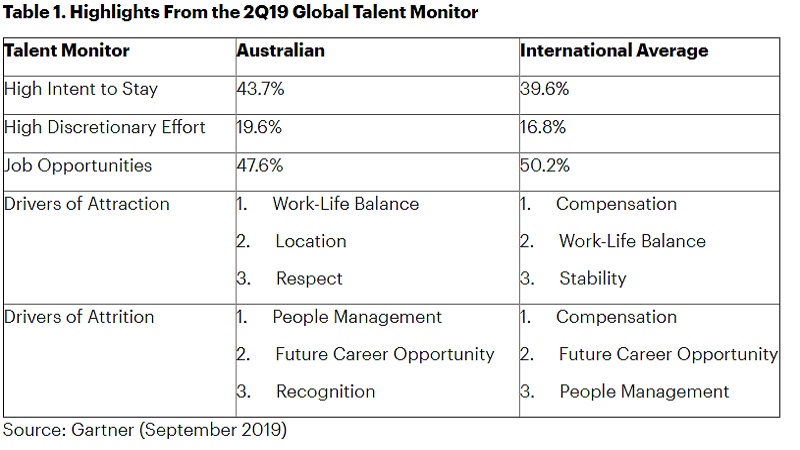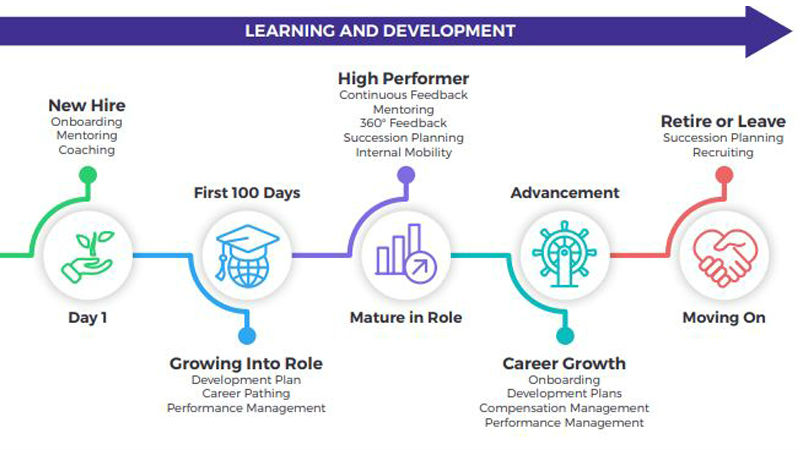Capitalize on People Development to Retain Employees

According to the latest Gartner research, Australian employees plan to stay with their current employers, with the numbers actively seeking new positions falling by almost seven percent. While on the one hand, that might give HR professionals a reason to smile; the reality is now is not the time to sit back and assume attraction and retention of talent is not a challenge.

Original source: Gartner
The Gartner study reaffirms my belief in the power of opportunity. Career opportunity to be precise. Now is the ideal time to implement a unified talent development strategy that builds a strong employer brand, encourages employee engagement and retention, and leads to increased productivity. This strategic approach ensures employees see not just a way to secure their future, but also a way to expand their skill arsenal.
HOW AN ORGANIZATION CAN DEVELOP EMPLOYEES, SO THEY STAY

Before we go any further, I want to be clear about one thing. Developing your employees is more than investing in training. It is a holistic approach that encompasses all aspects of the employee lifecycle. Think of it as your organization’s employee value proposition (EVP), the combination of benefits and rewards that an organization offers to its employees in return for their work and skills… a strong EVP also includes intangible components such as culture, opportunities for personal and professional development, and more”.
My colleague’s blog post, How to Use an Employee Value Proposition (EVP) to Attract Top Talent, provides a brief introduction to the many ways a strong EVP is the cornerstone of an organization’s talent development strategy. A robust EVP enables employers to create talent personas that relate to the specific roles they need to fill and highlight critical components of the job most attractive to these personas. Think of it like this, designers tend to be most interested in working with companies who have a strong sense of identity, brand, and aesthetic, while engineers and programmers are more likely to favor companies that prize and highlight their commitment to innovation and cutting-edge technologies. Tailoring EVPs to specific roles and individuals help organizations stand out in a big way.
THE FIVE ESSENTIAL CHARACTERISTICS OF AN EVP
According to Gartner, EVPs portray the value of working in an organization across five attributes:
- Opportunity: Can I learn and grow here? Is the company growing?
- People: Will I connect with my co-workers, manager, and can I see myself here? Do I have confidence in upper management?
- Organization: Is the company socially responsible? Do I connect to the causes it promotes? Are the products or services from the company those I place value in?
- Work: Will my new role facilitate a work-life balance?
- Rewards: What sort of compensation is on offer? What is the salary, the health benefits package, and how much paid time off is part of the package?
TECHNOLOGY’S ROLE IN YOUR EVP
The discussion around the profound changes artificial intelligence brought about – from attraction, onboarding to performance management — is not new. The changes are happening across the board, and HR professionals are all too aware of the transformational impact technology is having on their profession and their daily tasks.
While it is highly beneficial to have at your fingertips the means to automate performance reviews or onboarding, it is technology’s role in facilitating career paths for employees that seals the deal for me. When employees can see where and how they can progress within their company, they feel valued. Career pathing is also an invaluable tool as you design and implement your personalized succession plan. It enables employees and employers to see what skills a candidate possesses and what they require to be eligible for future opportunities.
FOUR STEPS TO ESTABLISHING CAREER PATHS
- Build an individual employee profile (IEP). Be sure to list include skills/competencies, education, and experience.
- Based on the IEP, identify what skills are missing and recommend the relevant training
- Incorporate manager input on skill gaps and recommendations
- Utilize your learning management system (LMS) to execute the development plan
To learn more about how a learning management system can boost retention, request a demo.
